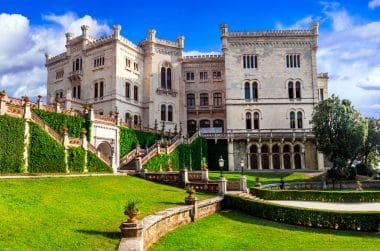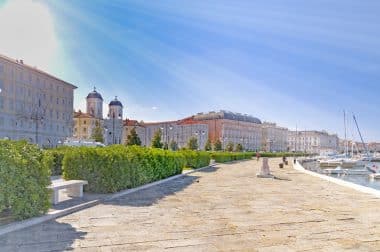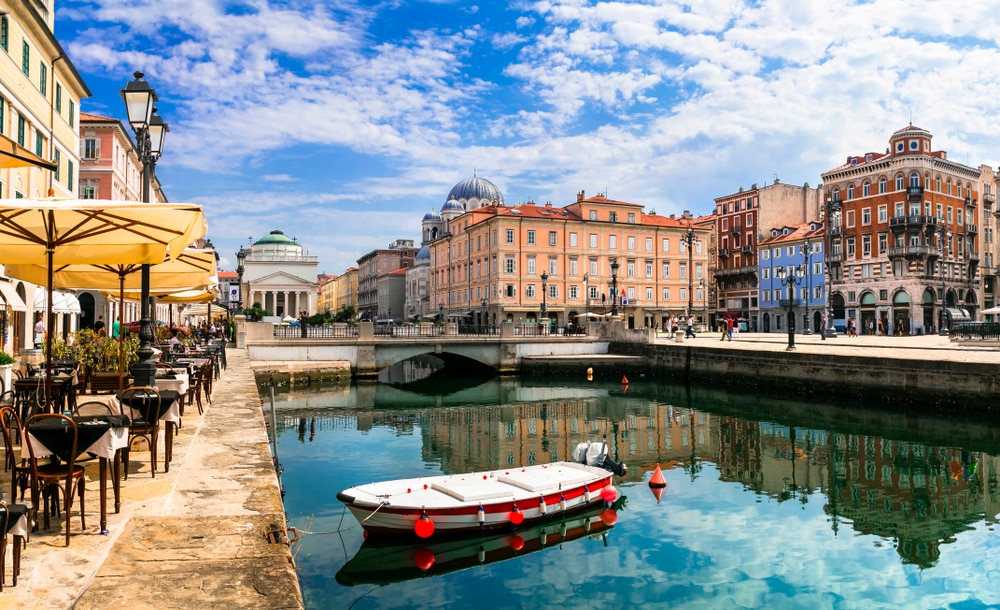There is probably hardly any other city in the world that has as many different names and epithets as Trieste in Italy. Trst, Tergeste, Little Vienna, City of Coffee, City of Three Winds and much more is called Trieste. In addition to all these imaginative names, Trieste’s special location envelops the idea of the city of a good 200,000 inhabitants with a good portion of enchantment and fairy dust. Trieste is still very close to Italian territory, Slovenia borders directly to the east. But between 1382 and 1918, Trieste was part of Austria-Hungary. Although the inhabitants felt more and more emotionally and culturally connected to Italy . This resulted in an exciting cultural mix that can still be felt in every fiber of the city today.
The cultural diversity of Trieste

The cultural heritage of the city is particularly anchored in the architecture of the city. There are a lot of stately-looking magnificent buildings that could just as well stand in Vienna, Prague or Budapest as they do here. While strolling through the city, I experience an architectural K.u.K. empire in miniature. But other ethnic groups, such as Jews, Serbs and Greeks, also left their mark on the picturesque port city. In addition to many Catholic church buildings, there is also an opulent Serbian Orthodox church in Trieste, the Church of the Holy Trinity and Saint Spyridon.
The largest Serbian Orthodox church in all of Italy was built between 1861 and 1866 in the neo-Byzantine style. Both its façade and its interior are worth a look. There are elaborate mosaics and depictions of saints to marvel at. Around Piazza Unità d’Italia beats both the Austrian and Italian heart of the city. The square is surrounded by numerous representative palazzi, which were built and furnished in an Austrian-Italian style mix. For example, the town hall, the Palazzo Municipio, which dates from 1875, and the Palazzo del Lloyd Triestino. You feel like you’re in the middle of Venice on the Grand Canal in the Theresian Quarter. The canal is lined with numerous traditional bars and cafés from which you can watch the hustle and bustle of boats sailing along the Grand Canal.
The most impressive sights and cultural institutions of Trieste

On the subject of sights in Trieste, one thing should be said in advance: The number of worthwhile places to visit is almost exuberant. During a holiday, hardly anyone will be able to appreciate all of Trieste’s outstanding sights and cultural institutions. So it’s best to plan another travel date after your first trip to Trieste in order to be able to continue the cultural walks through the city. One of the highlights is the Teatro Romano, which at the foot of the Colle di San Giusto once formed the ancient center of the city. The theater was built in the first century AD and held 6,000 spectators.
Of course, it looks a little dilapidated today, but it is still in good enough condition to act as a performance venue for the Teatro Romano Festival in summer. The Teatro Verdi is dedicated to the famous composer Giuseppe Verdi. Around 1850, premieres of several Verdi operas took place here. Today it is one of the best opera houses in all of Italy. The opera building, which was built in 1798 in the classicist style, is also a visual delight. Right next to it is the city’s Old Stock Exchange, which was inaugurated in 1806. One of its sides looks like a Doric temple, the rest of the building was designed in the Habsburg style.
If you are in Trieste, you should not miss a visit to the Castello di San Giusto. The medieval castle is considered a landmark of the city. The castle is located a little above the old town on a hill. From here, visitors have a wonderful panoramic view of Trieste, far beyond the Gulf of Trieste and the Karst, the rocky and calcareous plateau that surrounds the city.
Highlights around Trieste
In the immediate vicinity of the city there are even more places to visit, first and foremost the Miramare Castle, which is located in the middle of a marine park. Access is via the picturesque village of Duino, which sits above the bay of Grignano. Maximilian von Habsburg once had the castle built directly on a rocky outcrop. In the interiors, magnificent furnishings can be viewed. Miramare Castle is surrounded by a spacious park, which is designed in English and Italian garden style. Below the castle, in the marine park, visitors can get up to eye with numerous sea creatures during dives. The city tram line number 2 takes you to the karst mountains. From a height of 300 meters, you have a wonderful view over the sea, especially at sunset. The Grotta Gigante, in Borgo Grotta, is 15 kilometers from Trieste. Its nickname is the Giant Cave of Trieste, which is not surprising given a length of 380 meters. The cave may be visited.
Trieste’s Viennese-style coffee houses
In the 18th century, Trieste was a centre of the international coffee trade. This resulted in a deep rootedness of the city with the black drink. The coffee beans here are still of selected quality today. The city’s quaint coffee houses are bursting with Viennese charm. In the past, they were the meeting place for numerous writers who stayed in Trieste to be inspired by the unique city. James Joyce and Italo Svevo appreciated coffee houses, such as the Caffè degli Specchi, the Antico Caffè San Marco, or the Stella Polare. Today, there are numerous courses in Trieste for amateur baristas who want to learn how to prepare coffee perfectly


